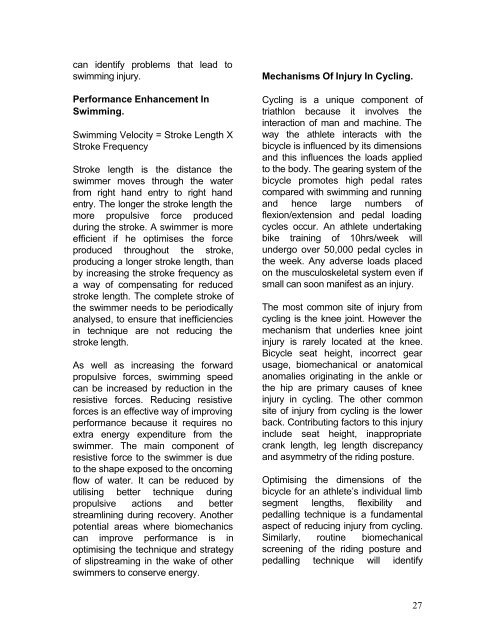MAXIMISING OLYMPIC DISTANCE TRIATHLON PERFORMANCE ...
MAXIMISING OLYMPIC DISTANCE TRIATHLON PERFORMANCE ...
MAXIMISING OLYMPIC DISTANCE TRIATHLON PERFORMANCE ...
You also want an ePaper? Increase the reach of your titles
YUMPU automatically turns print PDFs into web optimized ePapers that Google loves.
can identify problems that lead toswimming injury.Performance Enhancement InSwimming.Swimming Velocity = Stroke Length XStroke FrequencyStroke length is the distance theswimmer moves through the waterfrom right hand entry to right handentry. The longer the stroke length themore propulsive force producedduring the stroke. A swimmer is moreefficient if he optimises the forceproduced throughout the stroke,producing a longer stroke length, thanby increasing the stroke frequency asa way of compensating for reducedstroke length. The complete stroke ofthe swimmer needs to be periodicallyanalysed, to ensure that inefficienciesin technique are not reducing thestroke length.As well as increasing the forwardpropulsive forces, swimming speedcan be increased by reduction in theresistive forces. Reducing resistiveforces is an effective way of improvingperformance because it requires noextra energy expenditure from theswimmer. The main component ofresistive force to the swimmer is dueto the shape exposed to the oncomingflow of water. It can be reduced byutilising better technique duringpropulsive actions and betterstreamlining during recovery. Anotherpotential areas where biomechanicscan improve performance is inoptimising the technique and strategyof slipstreaming in the wake of otherswimmers to conserve energy.Mechanisms Of Injury In Cycling.Cycling is a unique component oftriathlon because it involves theinteraction of man and machine. Theway the athlete interacts with thebicycle is influenced by its dimensionsand this influences the loads appliedto the body. The gearing system of thebicycle promotes high pedal ratescompared with swimming and runningand hence large numbers offlexion/extension and pedal loadingcycles occur. An athlete undertakingbike training of 10hrs/week willundergo over 50,000 pedal cycles inthe week. Any adverse loads placedon the musculoskeletal system even ifsmall can soon manifest as an injury.The most common site of injury fromcycling is the knee joint. However themechanism that underlies knee jointinjury is rarely located at the knee.Bicycle seat height, incorrect gearusage, biomechanical or anatomicalanomalies originating in the ankle orthe hip are primary causes of kneeinjury in cycling. The other commonsite of injury from cycling is the lowerback. Contributing factors to this injuryinclude seat height, inappropriatecrank length, leg length discrepancyand asymmetry of the riding posture.Optimising the dimensions of thebicycle for an athlete’s individual limbsegment lengths, flexibility andpedalling technique is a fundamentalaspect of reducing injury from cycling.Similarly, routine biomechanicalscreening of the riding posture andpedalling technique will identify27


